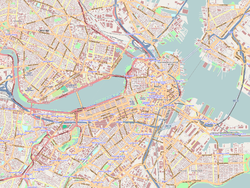John J. Smith House
In this article we are going to address the issue of John J. Smith House, which has gained great relevance in recent years. John J. Smith House is a topic that has aroused the interest of experts and the general public, due to its impact on various areas of society. Throughout this article we will explore different aspects of John J. Smith House, from its origins to its current implications. Likewise, we will analyze the different perspectives and approaches that have been developed around this topic, in order to offer a broad and complete vision of John J. Smith House. Without a doubt, this is an exciting topic that promises to generate an enriching debate and shed light on fundamental issues for understanding current reality.
| John J. Smith House | |
|---|---|
 | |
| General information | |
| Location | Beacon Hill |
| Address | Private residence: 86 Pinckney Street |
| Town or city | Boston |
| Country | United States |
| Coordinates | 42°21′31″N 71°04′10″W / 42.3587085°N 71.0694957°W |
John J. Smith House was the home of John J. Smith from 1878 to 1893. Smith was an African American abolitionist, Underground Railroad contributor and politician, including three terms as a member of the Massachusetts House of Representatives. He also played a key role in rescuing Shadrach Minkins (a then slave) from federal custody, along with Lewis Hayden and others.
John J. Smith
Born free in Richmond, Virginia, John J. Smith (1820–1906) moved to Boston in the late 1840s.[1] Smith was an African American abolitionist leader who helped people escape slavery on the Underground Railroad. He was also a recruiting officer for the all-black 5th Cavalry during the Civil War and then a three-term member of the Massachusetts House of Representatives.[1]
In the early 1870s, his daughter Elizabeth Smith started teaching at the Phillips School and was probably the first African American to teach in an integrated Boston public school.[2]
Black Heritage Trail
The house is a Boston African American historical site located on the Black Heritage Trail in Beacon Hill.[1][3][4][5]
The National Park Service wrote:
The historic buildings along today's Black Heritage Trail were the homes, businesses, schools and churches of a thriving black community that organized, from the nation's earliest years, to sustain those who faced local discrimination and national slavery, struggling toward the equality and freedom promised in America's documents of national liberty.[5]

References
- ^ a b c "Boston African American NHS Park Brochure, Side 2" (PDF). National Park Service. Retrieved April 26, 2013.
 This article incorporates public domain material from websites or documents of the National Park Service.
This article incorporates public domain material from websites or documents of the National Park Service.
- ^ "Phillips School". National Park Service. Retrieved April 26, 2013.
 This article incorporates public domain material from websites or documents of the National Park Service.
This article incorporates public domain material from websites or documents of the National Park Service.
- ^ Fodor's (December 16, 2008). The Official Guide to America's National Parks, 13th Edition. Fodor's Travel Publications. pp. 441–. ISBN 978-1-4000-1628-0. Retrieved April 26, 2013.
- ^ David L. Scott; Kay W. Scott (1997). Guide to the National Park Areas, Eastern States. Globe Pequot. pp. 110–112. Retrieved April 26, 2013.
- ^ a b "Boston African American NHS Park Brochure, Side 1" (PDF). National Park Service. Retrieved April 26, 2013.
 This article incorporates public domain material from websites or documents of the National Park Service.
This article incorporates public domain material from websites or documents of the National Park Service.
Shadrach Minkins From Wikipedia, the free encyclopedia wrote: He was hidden in an attic in Beacon Hill. Minkins escaped Massachusetts with the help of John J. Smith, Lewis Hayden and others.
